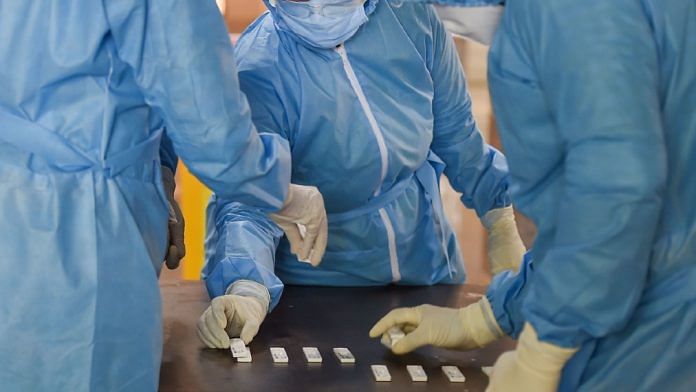New Delhi: The results of India’s first large-scale study to assess Covid-19 exposure have shown that less than 1 per cent of the country’s population has been infected by the virus.
The government said Thursday the results show lockdown and containment measures were successful in preventing a rapid surge in the number of cases, though a large proportion of the population still remains susceptible. It also asserted that India is not in the community transmission stage.
Speaking at a media briefing Thursday, Dr Balram Bhargava, Director General of Indian Council of Medical Research, said the results corroborate that India has the lowest number of cases and deaths per lakh population in the world.
In the sero surveillance survey, blood samples were collected and tested for antibodies called IgG that show the presence of past infection of Covid-19.
The survey conducted in May 2020 across 83 districts in 26,400 individuals showed that 0.73 per cent of India’s population was exposed to the virus.
“This means that the lockdown and containment has been successful in keeping it low and preventing rapid spread in the last three months,” said Bhargava, adding that this means a large proportion of the population is still susceptible to the infection.
The study showed that the infection fatality rate — the proportion of deaths among all the infected individuals (diagnosed and undiagnosed) — was 0.08 per cent, and that’s “very good news”, said Bhargava.
“We are definitely not in community transmission,” he said, explaining that despite the debate around the term, the low prevalence in districts proves the spread of the infection is not widespread in the country even though it is high in cities and containment zones.
While this proves the virus is present in the population, the mortality rate due to the virus is low, said NITI Ayog member Dr V.K. Paul, who was also present at the briefing. He said the mortality rate in India has recently fallen to 2.8 per cent from 3.3 per cent.
Calling the study “possibly the largest serosurveillance”, he explained that since it was conducted in the second week of May, and as antibodies take upto 15 days to develop, the survey results reveal the situation around April 30, the fifth week of the lockdown.
Also read: WHO says Covid transmission through asymptomatic patients ‘very rare’, experts disagree
‘High-risk groups need to be protected’
The study showed risk of infection in the urban areas and urban slums is 1.09 times and 1.89 times higher, respectively, than in rural areas.
However, Bhargava said, the infection in containment zones was high with significant variations, adding the study is still on.
Since India’s population is still largely susceptible to the infection, India still needs to use non-pharmacological interventions like physical distancing, use of face masks, hand hygiene and cough etiquette, Bhargava emphasised.
“We need to continue early treatment, quick management and timely testing as strategies to control the spread of the disease”, Paul said.
Bhargava said high risk groups such as the elderly, those with chronic morbidities, pregnant women and children below 10 years of age should be protected.
“It is only with strong implementation of the containment strategies that the spread of the disease can be limited. States cannot lower their guard and need to keep implementing effective surveillance and containment strategies,” Bhargava said.
The sero survey
The sero-survey, launched by the ICMR in May in collaboration with state health departments, the National Centre for Disease Control and the World Health Organization, is being conducted in two parts. The first, Bhargava said at the briefing, is the estimate fraction of population that has been infected with SARS-CoV-2 in general population, and the second is estimate fraction of population infected with the coronavirus in containment zones of hotspot cities.
While the first part has been completed, the second is going on.
The figures shared with the media said data from 65 districts has been compiled until now.
Also read: 60 districts, 10 cities — how ICMR is going deep into India’s heart to chart Covid course



